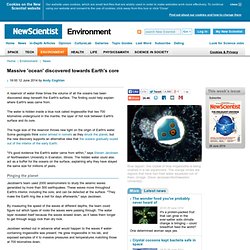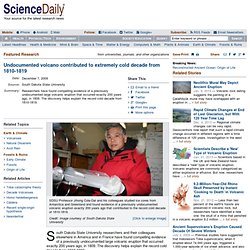

Massive 'ocean' discovered towards Earth's core - environment - 12 June 2014. A reservoir of water three times the volume of all the oceans has been discovered deep beneath the Earth's surface.

The finding could help explain where Earth's seas came from. The water is hidden inside a blue rock called ringwoodite that lies 700 kilometres underground in the mantle, the layer of hot rock between Earth's surface and its core. The huge size of the reservoir throws new light on the origin of Earth's water. Some geologists think water arrived in comets as they struck the planet, but the new discovery supports an alternative idea that the oceans gradually oozed out of the interior of the early Earth.
"It's good evidence the Earth's water came from within," says Steven Jacobsen of Northwestern University in Evanston, Illinois. Pinging the planet Jacobsen's team used 2000 seismometers to study the seismic waves generated by more than 500 earthquakes. Jacobsen worked out in advance what would happen to the waves if water-containing ringwoodite was present. Damp down there. Undocumented volcano contributed to extremely cold decade from 1810-1819. South Dakota State University researchers and their colleagues elsewhere in America and in France have found compelling evidence of a previously undocumented large volcanic eruption that occurred exactly 200 years ago, in 1809.

Massive volcanic eruption puts past climate and people in perspective. The 5 Most Spectacular Landscapes on Earth (That Murder You) Mother Nature is an evil bitch that wants us dead.

We know this, we accept it, we try to burn one plant a day as petty revenge against her for it and we move on with our lives. But sometimes her traps are so unsubtle, so obviously, blatantly designed to do nothing but murder human beings in the most awful ways possible that we can't help but stand and applaud her sheer balls. In that spirit, here are five of Mother Nature's more vicious bear traps: #5. Tsingy de Bemaraha National Park -- Madagascar Olivier Lejade The Tsingy de Bemaraha National Park is a protected UNESCO world heritage site, but this park doesn't need any tollbooths, rangers or even a tall, spiked fence. WikipediaSometimes the Earth gives a freebie to the World of Warcraft design team.
Biologists call the area a bio-fortress. National GeographicSometimes a forest of daggers just isn't enough. Olivier LejadeSo yeah. Marco ZanferrariSometimes the formations produce Yes album covers just to mess with you. #4. World's biggest volcano was born in the dinosaur age - environment - 06 September 2013. Take that, Nessie.

A far bigger aquatic monster lies deep beneath the Pacific Ocean, just off the coast of Japan: a colossal volcano larger than any other yet found on Earth. By one measure, it is even joint first in the league table of largest volcanoes in the solar system, alongside Olympus Mons on Mars. Called the Tamu Massif, its dome-shaped expanse covers 300,000 square kilometres, matching the area of the British Isles and Olympus Mons.
But Mars aficionados need not fret. The 5 Most Mind-Blowing Things That Can Be Found Underwater. Exploring the depths via scuba or free diving is one of those things that seems really cool in theory.

Then you swim around in a pool for 36 hours, go to the man-made lake you heard had a flooded town and discover a bunch of muddy brick foundations. Deadly lake turns animals into statues - environment - 01 October 2013. (Images: Nick Brandt) ACCORDING to Dante, the Styx is not just a river but a vast, deathly swamp filling the entire fifth circle of hell.

Perhaps the staff of New Scientist will see it when our time comes but, until then, Lake Natron in northern Tanzania does a pretty good job of illustrating Dante's vision. Unless you are an alkaline tilapia (Alcolapia alcalica) – an extremophile fish adapted to the harsh conditions – it is not the best place to live. Temperatures in the lake can reach 60 °C, and its alkalinity is between pH 9 and pH 10.5. The lake takes its name from natron, a naturally occurring compound made mainly of sodium carbonate, with a bit of baking soda (sodium bicarbonate) thrown in. Photographer Nick Brandt, who has a long association with east Africa – he directed the video for Michael Jackson's Earth Song there in 1995 – took a detour from his usual work when he discovered perfectly preserved birds and bats on the shoreline. New Scientist Not just a website! Recommended by.
5 Acts of Nature That Rearranged the Face of the Planet. It's only natural that we tend to focus on the human side of earthquakes, tsunamis and other disasters when they happen.

But sometimes you have to step back and really appreciate the sheer, unfathomable scale of how these events can change the surface of the Earth itself. The world is a volatile place, and we'd do well to not let ourselves forget it. With that in mind, consider the earth-shattering power of ... In 1883, the island of Krakatoa in the Indian Ocean exploded like a potato in a microwave, except with less delicious Idaho goodness and with more tsunamis.
The blast was so powerful that the noise could be heard from more than 2,000 miles away. Obviously, this did not happen spontaneously -- islands don't randomly explode, or else no one would live on islands. However it happened, the impact was huge. Via Wikimedia Commons Aaaaand this one after: